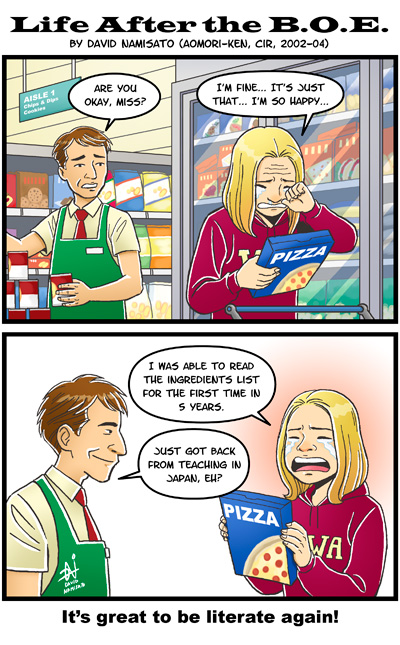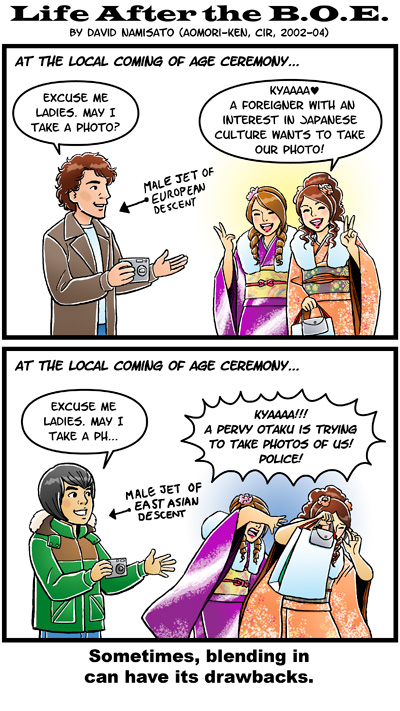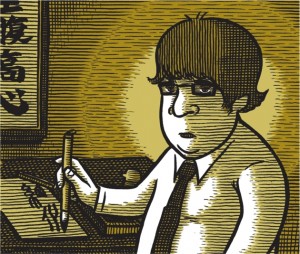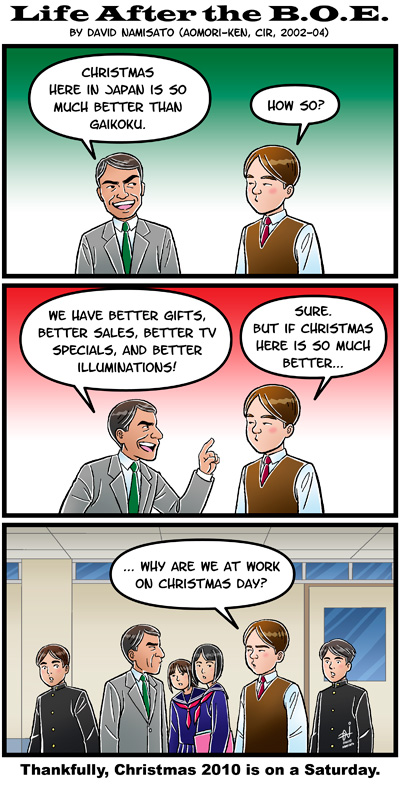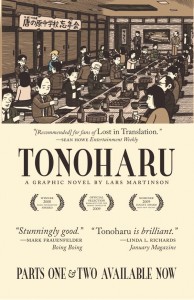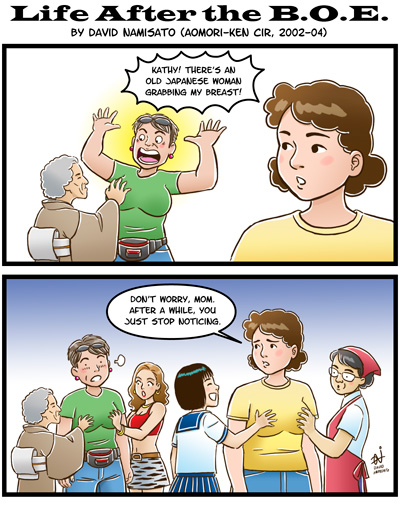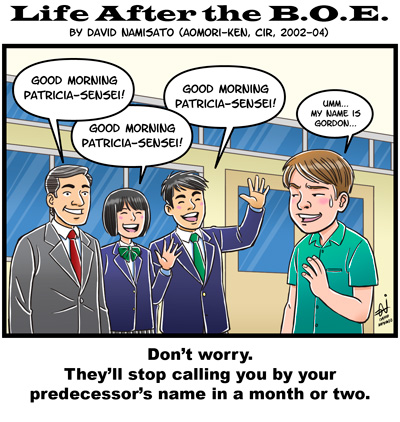Life After the B.O.E. is a comic series about the JET experience by David Namisato (Aomori-ken, 2002-2004), a professional illustrator currently living in Toronto.
Visit David’s website at www.namisato.org.
JETs in the News: Lars Martinson featured in Japan Times article on ex-pat comics
********
JET alum/cartoonist Lars Martinson (Fukuoka-ken 2003-2006), author of the graphic novels Tonoharu: Part Two and Tonoharu: Part 1, is the focus (along with Adam Pasion, author of the Sundogs anthologies) of a thoughtful Japan Times article by Gianni Simone on comics about Japan “that tell it like it is.”
Here’s the link to the article: http://search.japantimes.co.jp/cgi-bin/fl20110205a1.html
And below are a few excerpts about Martinson from the article:
The comic life of expats in Japan
Americans Lars Martinson and Adam Pasion tell it like it is with cutting-edge manga
By GIANNI SIMONE Special to The Japan Times
Tales of expat life in Japan all too often get blown out of proportion and quickly become picaresque adventures that little resemble real life.
**********
Luckily for us, many comic artists who have lived here seem to be more level-headed and have tackled the subject with a more realistic, no-nonsense approach.
**********
As the title suggests, “Tonoharu: Part Two” is not Martinson’s first foray in the field of expat comics: He self-published the first volume of this four-part saga in 2008 thanks to a grant from the prestigious Xeric Foundation.
Martinson, 33, first arrived in Japan in 2003 to work as an assistant language teacher, and spent the next three years working at a junior high school in a small town in Fukuoka Prefecture. His second stint in this country was in 2008 when he studied East Asian calligraphy under the auspices of a two-year research scholarship from the Japanese government.
Travel had played a pivotal role in his life (he had lived in Thailand and Norway as well), so when he came up with the idea of producing a graphic novel, he decided to make foreign travel a central theme.
“I planned from the start to turn my Japanese experience into a comic,” Martinson says, “even though I didn’t want it to be a mere autobiographical story. So I chose a 20-something American like me as the protagonist, but added a fictional group of eccentric expatriates living in the same rural Japanese town.”
At times living in the middle of nowhere was a challenge. Still, Martinson has no regrets about those three years spent in Kyushu.
“I’m actually a city slicker,” confesses Martinson, “and would love to live in a huge city in Japan at some point. Also, I’m sure that expat communities are awesome, but they can also separate you from the native population. When you live out in the country, you don’t have the option to just hang out with other Westerners, and this can force you to get involved in the host culture in ways you probably wouldn’t otherwise.”
Click here to read the full article: http://search.japantimes.co.jp/cgi-bin/fl20110205a1.html
Click here to read more JetWit posts about Lars Martinson:
Click here for Lars Martinson’s official blog/website: http://larsmartinson.com
Life After the B.O.E.: Blending In
Life After the B.O.E. is a comic series about the JET experience by David Namisato (Aomori-ken, 2002-2004), a professional illustrator currently living in Toronto.
Visit David’s website at www.namisato.org.
JET alum/cartoonist Lars Martinson gives radio interview
Check out this great radio interview with JET alum/cartoonist Lars Martinson (Fukuoka-ken 2003-2006), creator of the four-part graphic novel Tonoharu. Lars talked with radio station KFAI out Minnesota in December. Hear him talk about the creation of his book, which tells the tale of an ALT wrestling with the challenges of living in rural Japan (sound familiar, anyone?). Lars lived in rural Fukuoka for three years and spent several years post-JET crafting the novel based on his experiences.
For those who are interested, Tonoharu Part I and Part II (which just hit book shelves in November) can be found here:
Also be sure to check out JetWit’s recent interview with Lars Martinson.
Life After the B.O.E.: Better Christmas
Life After the B.O.E. is a comic series about the JET experience by David Namisato (Aomori-ken, 2002-2004), a professional illustrator currently living in Toronto.
Visit David’s website at www.namisato.org.
Justin’s Japan: Interview with ‘Tonoharu’ Cartoonist/JET Alum Lars Martinson
By JQ magazine’s Justin Tedaldi (CIR Kobe-shi, 2001-02) for Examiner.com. Visit his NY Japanese Culture page here to subscribe for free alerts on newly published stories.
Minnesota-based cartoonist Lars Martinson went to Japan in 2003 to teach English on the JET Program, an exchange initiative sponsored by the Japanese government. During his three-year stay in rural Fukuoka, he was inspired to break ground on an ambitiously stylized four-part graphic novel named Tonoharu (Pliant Press) based on the trials and tribulations of living in Japan. Part Two was released in November, and I caught up with the artist to discuss the series so far and Japanese life through an expat’s eyes.
How would you describe the differences in Tonoharu: Part Two compared to the previous book? Did you do anything different in terms of storytelling or approach?
With each volume I’ve tried to explore different facets of living abroad. The first book focuses on the sense of loneliness and isolation that occurs after the “honeymoon period” of cultural acclimation ends. The second book deals with the relationships that develop, both with members of the native population and with other expats.
My approach to storytelling has gotten more deliberate as I’ve gone along. For Tonoharu: Part One, I started by writing “Page 1, Scene 1” at the top of a piece of paper and launching into a detailed script before I had a clear sense of what direction I wanted the story to go in. Diving straight into minutiae like that is like working on the interior design of a house that hasn’t been built yet; you should know how big the windows are before you pick out the curtains. So for Part Two—and now Part Three—I’ve given much more thought to the structure of the story, and made sure I was happy with the big picture before I got too wrapped up in details and nuance.
Tell us about your experiences on the JET Program. What made you choose to apply, and what was your overall take on the three years that you were there for?
When I was 16, I lived with a host family in Nagoya for a summer vacation exchange. The experience inspired a lifelong interest in international travel. I’d go on to live in Thailand and Norway for a year apiece as an exchange student, and visit a dozen or so other countries as a tourist. After I graduated from college, I wanted to try working abroad, and also wanted to return to Japan. A friend of mine introduced me to the JET Program, and I knew immediately that it was right for me. And sure enough, my three years in the JET Program were among the best I’ve ever had.
All JET participants hit high and low points while in Japan. What were some of yours?
My elementary school classes were among the most satisfying experiences. I planned all the lessons pretty much single-handedly, so once I got the hang of it, it was gratifying to see how excited the kids were about learning English, and how much they retained.
One of the more frustrating aspects of the experience, at least in the beginning, was the language barrier. It’s hard to form meaningful friendships when you can’t—y’know—talk to people. So it was always sad when I wanted to befriend someone and they clearly wanted to befriend me, but the logistics of not being able to communicate effectively got in the way.
Last summer, it was announced that the JET Program is facing sweeping budget cuts that may endanger its future. What’s your take on the value of the program in today in Japan and in the participants’ home countries?
I suppose with the economy being what it is, some cuts are probably inevitable. But I really hope they don’t gut the JET Program. My life has been enhanced beyond measure by having the opportunity to interact with foreign cultures, and I hope Japanese students will continue to be given the same opportunity. It’s hard to quantify the benefits of the JET Program, but that doesn’t really make them any less real or important.
What kind of feedback on the books have your received from JETs and those associated with the Japanese community?
I’ve tried to make the book accessible to readers regardless of their background, but it goes without saying that those who are familiar with Japan or the JET Program are able to appreciate it on a different level. JETs tend to pick up on all these little details in the books that other readers breeze pass without notice. I remember a JET alum commenting on a scene in Part One where the main character wears a fancy suit to his first day on the job, but since it’s summer vacation everyone else in the teacher’s room is wearing ratty gym clothes. It’s little things like that that you’d only consciously notice if you’d been in that situation yourself.
Click here for the rest of the interview.
Lars Martinson interviewed in Hero Magazine re “Tonoharu: Part 2”
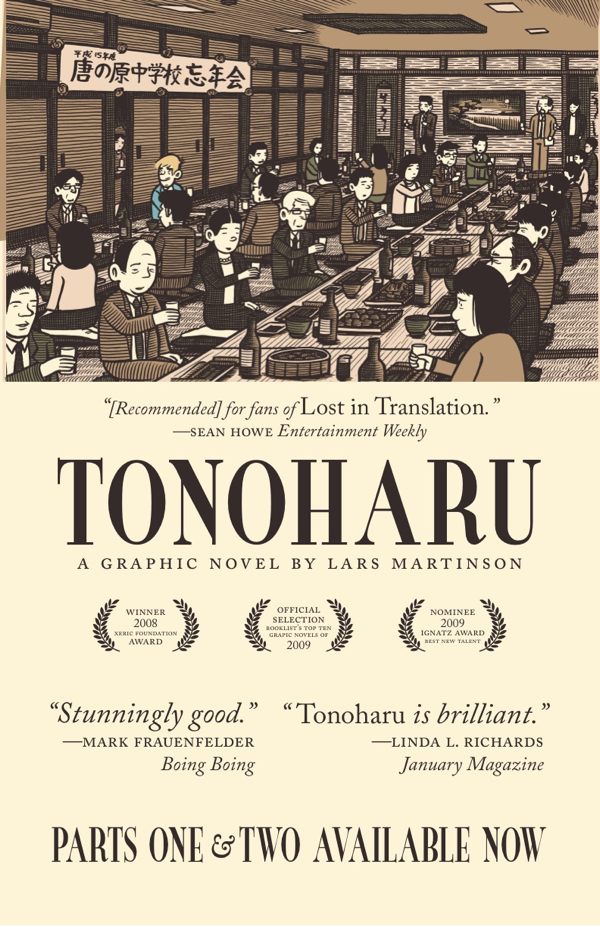 There’s a nice interview with JET alum Lars Martinson in Hero Magazine. Lars recently published Tonoharu: Part 2, a graphic novel about teaching English in Japan that follows up on the success of Tonoharu: Part 1.
There’s a nice interview with JET alum Lars Martinson in Hero Magazine. Lars recently published Tonoharu: Part 2, a graphic novel about teaching English in Japan that follows up on the success of Tonoharu: Part 1.
Here’s the link to the article: http://heromagazine.org/?p=189
Life After the B.O.E.: Autograph
Life After the B.O.E. is a comic series about the JET experience by David Namisato (Aomori-ken, 2002-2004), a professional illustrator currently living in Toronto.
Visit David’s website at www.namisato.org.
Lars Martinson’s “Tonoharu: Part Two” reviewed by BoingBoing
JET alum Lars Martinson recently released his follow-up graphic novel Tonoharu: Part 2. Here’s the review by Mark Frauenfelde of BoingBoing:
“Tonoharu Part Two: Excellent graphic novel about an English teacher in Japan”: http://www.boingboing.net/2010/11/10/tonoharu-part-two-ex.html
(Editor’s note: I have a copy of Tonoharu: Part 1, and every time I show it to a fellow JET alum and they start reading it, they end up reading the whole thing (which takes about 15 minutes). It’s really terrific and very unique.)
Instant Noodle Comics is a new cartoon by Shun Endo (Ibaraki Prefecture, 1998-2001), who also served as Treasurer and Webmaster for JETAA Pacific Northwest. He works as a Game Artist at Real Networks( Gamehouse Studios). To see more of his cartoons go to instantnoodlescomics.com.
Click the image to see the full comic!
Life After the B.O.E.: Inappropriate Touching
Life After the B.O.E. is a comic series about the JET experience by David Namisato (Aomori-ken, 2002-2004), a professional illustrator currently living in Toronto.
Visit David’s website at www.namisato.org.
Second Volume of JET-inspired Graphic Novel Now Available
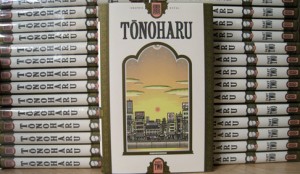 JET alum/cartoonist Lars Martinson (Fukuoka-ken 2003-2006) has this to share:
JET alum/cartoonist Lars Martinson (Fukuoka-ken 2003-2006) has this to share:
“I just got copies of my second graphic novel Tonoharu: Part Two back from the bindery. The book won’t be available in stores until next month, but I’m selling them on my website right now if anyone’s interested.”
A link to order the book, as well as information about Tonoharu: Part One and Two, can be found here:
Click here to see previous JetWit posts about Tonoharu: Part Two and Tonoharu: Part 1.
Life After the B.O.E.: Chopsticks
Life After the B.O.E. is a comic series about the JET experience by David Namisato (Aomori-ken, 2002-2004), a professional illustrator currently living in Toronto.
Visit David’s website at www.namisato.org.
Books: Lars Martison’s “Tonoharu” gets favorable write-up on BoingBoing, makes Amazon’s Top Ten Bestselling Graphic Novels list
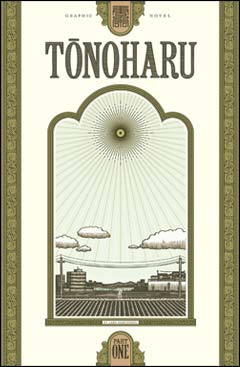 There’s a nice review of JET alum Lars Martinson’s graphic novel Tonoharu: Part 1 on the BoingBoing site written by Mark Frauenfelder titled “Tonoharu: Excellent graphic novel about an English teacher in Japan.” And according to Lars’ blog,
There’s a nice review of JET alum Lars Martinson’s graphic novel Tonoharu: Part 1 on the BoingBoing site written by Mark Frauenfelder titled “Tonoharu: Excellent graphic novel about an English teacher in Japan.” And according to Lars’ blog,
“Thanks to Mark Frauenfelder’s writeup about Tonoharu: Part One on Boing Boing, the book has made it into Amazon.com’s Top Ten Bestselling Graphic Novels today!”
Here’s the link to the review: http://www.boingboing.net/2010/08/27/tonoharu-excellent-g.html
Here’s a quote from the review:
“Published in 2008, and a winner of the prestigious Xeric Award, Tonoharu is a story of isolation, frustration, and mystery, with just the right amount of black humor to keep it from being depressing.”
For fans awaiting the next installment, Tonoharu: Part 2 is due out in December.
Life After the B.O.E.: Your Name
Life After the B.O.E. is a comic series about the JET experience by David Namisato (Aomori-ken, 2002-2004), a professional illustrator currently living in Toronto.
Visit David’s website at www.namisato.org.

